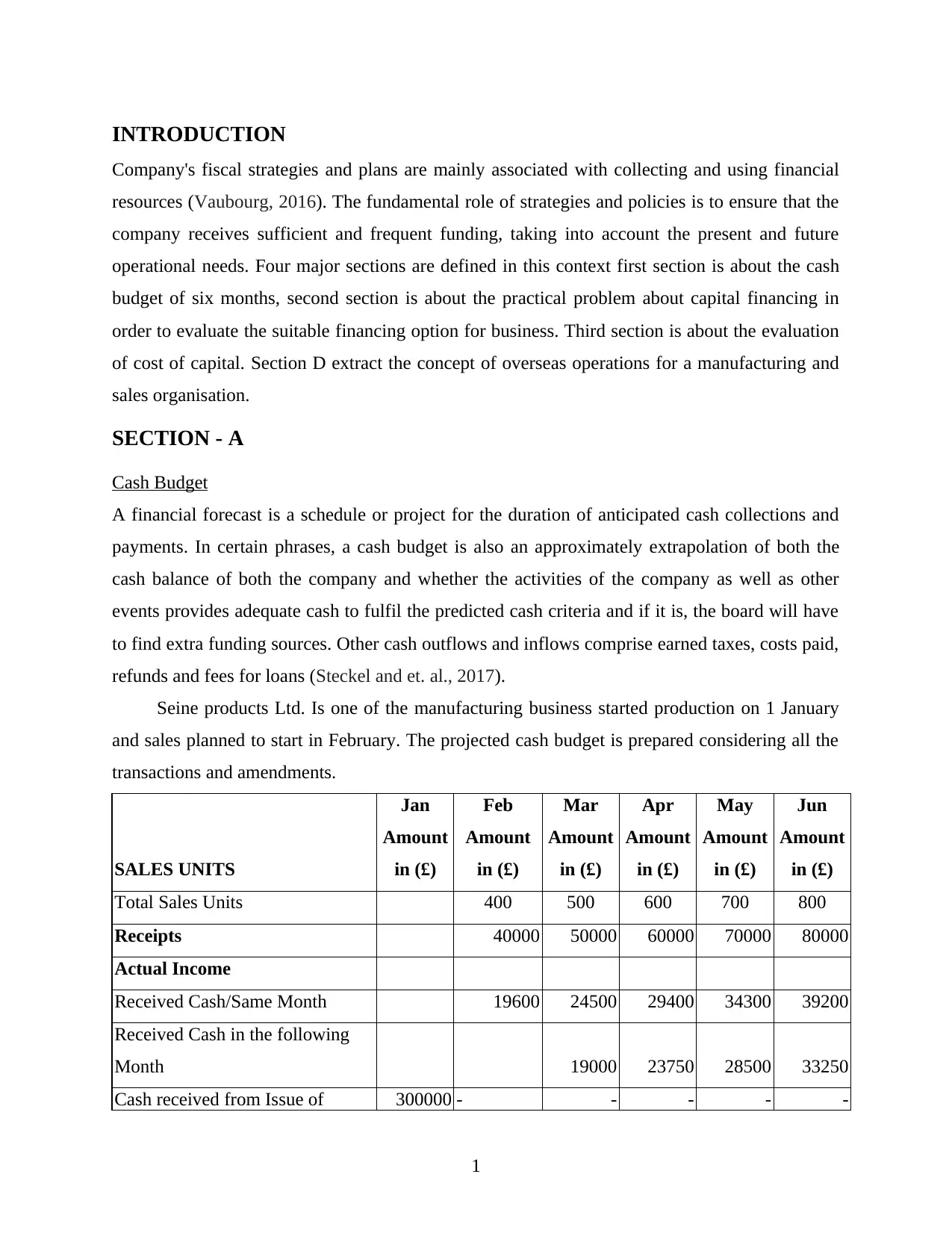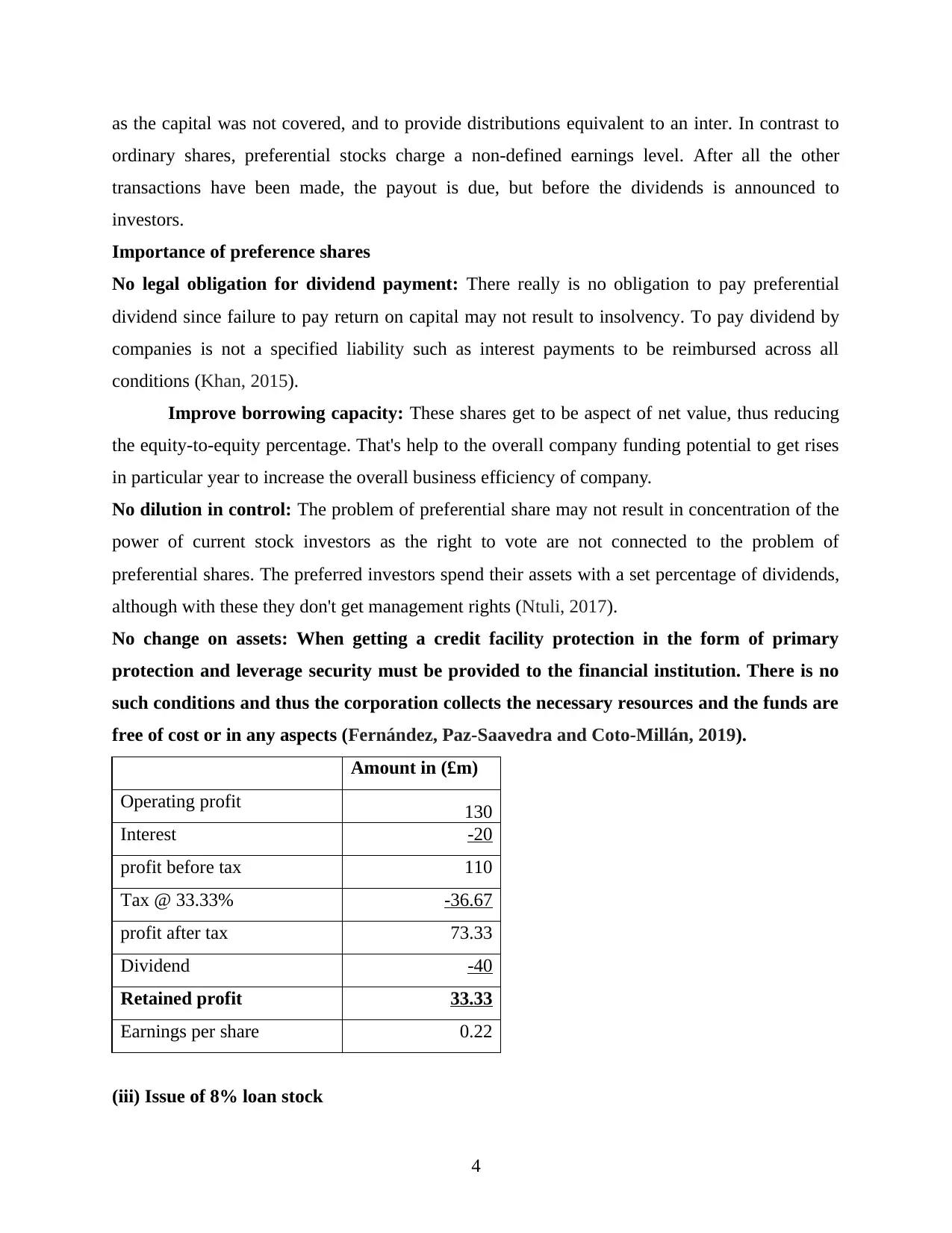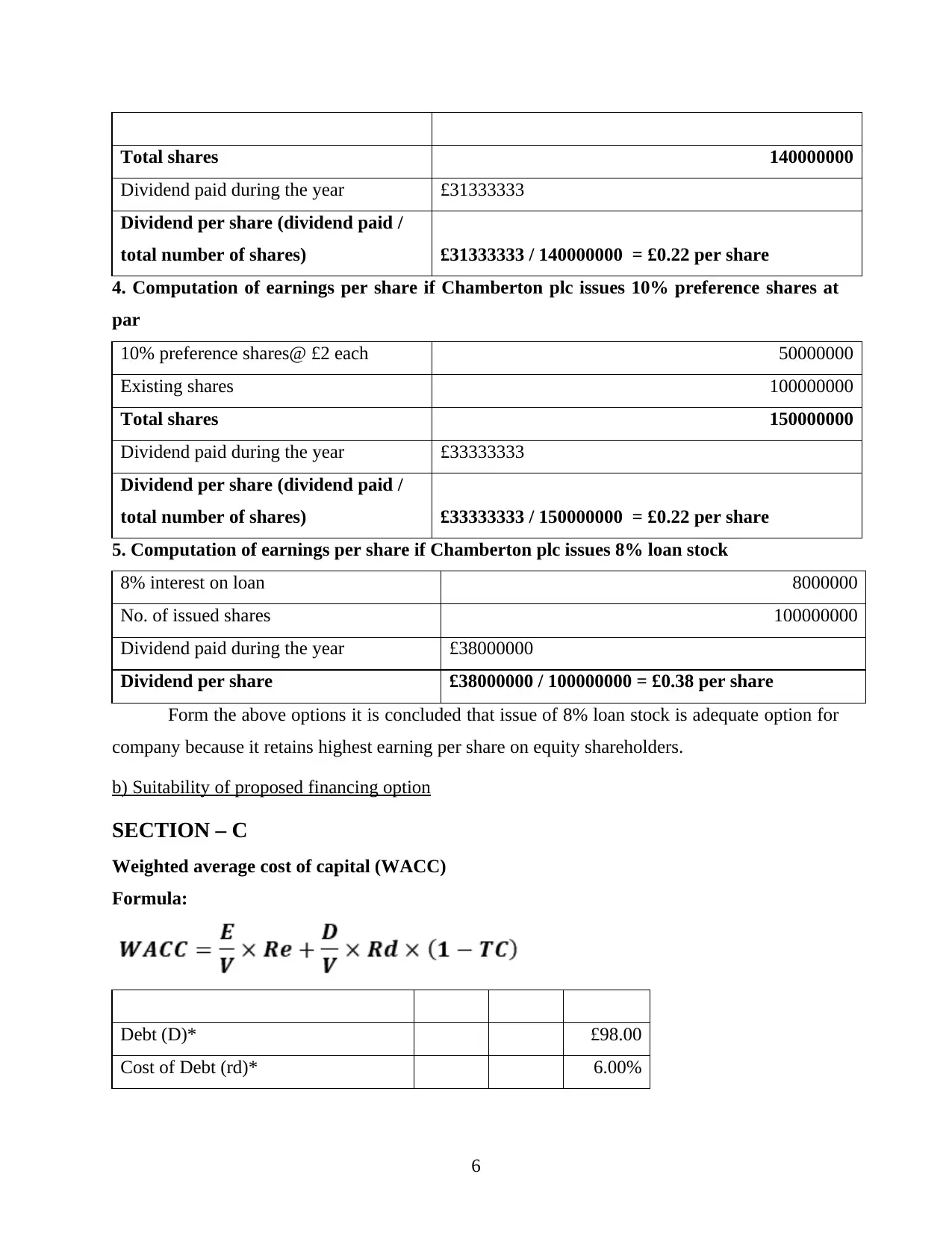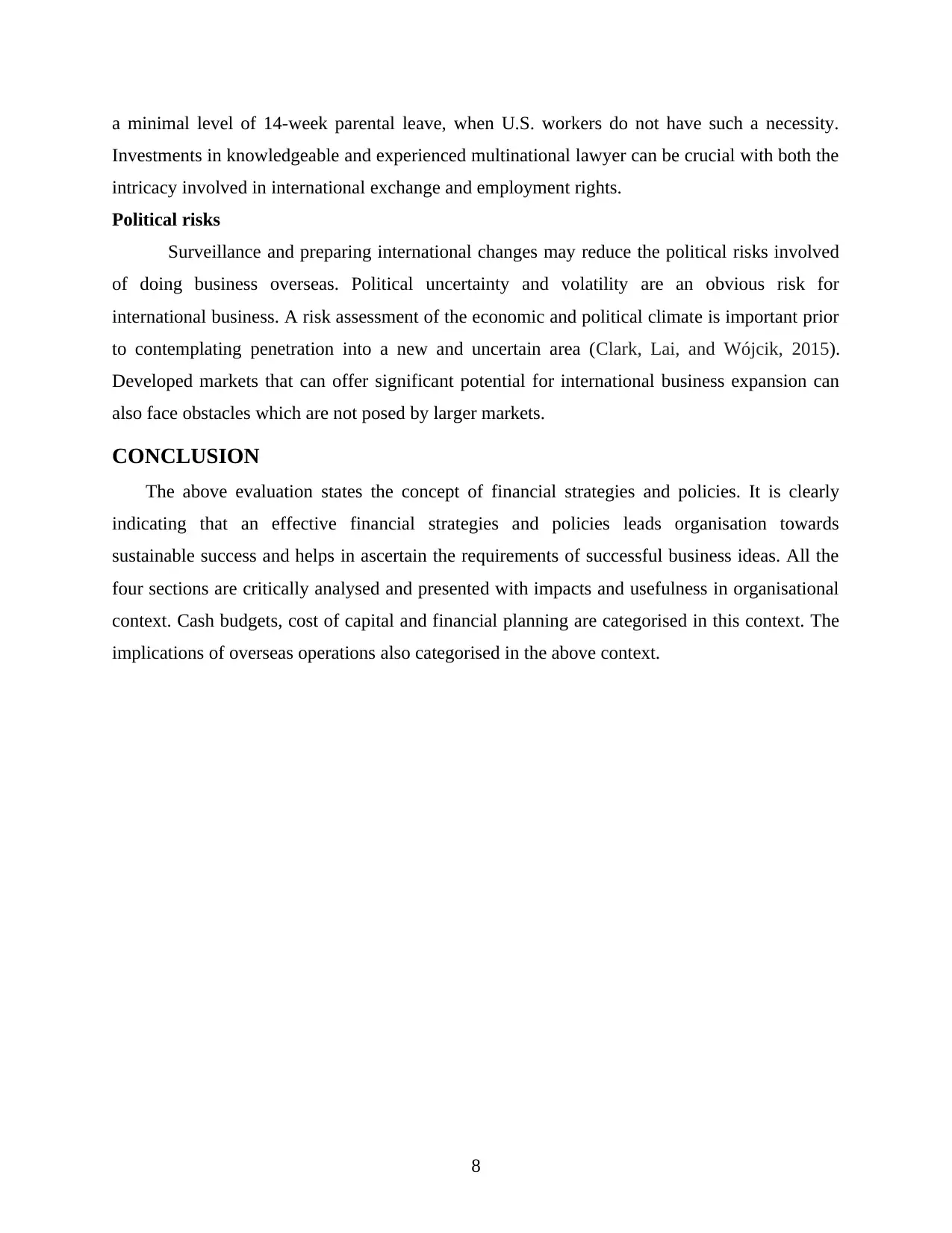Financial Strategy and Policy Report: Seine Products Ltd. Analysis
VerifiedAdded on 2023/01/19
|11
|2554
|35
Report
AI Summary
This report provides a comprehensive analysis of financial strategy and policy, encompassing several key areas. Section A focuses on a six-month cash budget for Seine Products Ltd., detailing projected sales, receipts, payments, and cash flow. Section B delves into the practical problem of capital financing, evaluating three proposed financing options: issuing right shares, preference shares, and loan stock. It analyzes the features, suitability, and impact on earnings per share of each option, concluding that issuing 8% loan stock is the most suitable option. Section C calculates the weighted average cost of capital (WACC). Section D addresses the challenges and considerations for Rosdeaye Ltd., a UK manufacturing entity, in establishing overseas operations, specifically in the Caribbean. The report highlights labor market variations, political risks, and the importance of strategic planning for successful international expansion. The analysis provides insights into financial planning, cost of capital, and the implications of overseas operations.

FINANCIAL STRATEGY
AND POLICY
AND POLICY
Paraphrase This Document
Need a fresh take? Get an instant paraphrase of this document with our AI Paraphraser

Contents
INTRODUCTION...........................................................................................................................1
SECTION - A..................................................................................................................................1
Cash Budget............................................................................................................................1
SECTION – B..................................................................................................................................2
a) Important features of each of the three proposed financing options..................................2
b) Suitability of proposed financing option............................................................................6
SECTION – C..................................................................................................................................6
SECTION – D..................................................................................................................................7
CONCLUSION................................................................................................................................8
REFERENCES................................................................................................................................9
INTRODUCTION...........................................................................................................................1
SECTION - A..................................................................................................................................1
Cash Budget............................................................................................................................1
SECTION – B..................................................................................................................................2
a) Important features of each of the three proposed financing options..................................2
b) Suitability of proposed financing option............................................................................6
SECTION – C..................................................................................................................................6
SECTION – D..................................................................................................................................7
CONCLUSION................................................................................................................................8
REFERENCES................................................................................................................................9

INTRODUCTION
Company's fiscal strategies and plans are mainly associated with collecting and using financial
resources (Vaubourg, 2016). The fundamental role of strategies and policies is to ensure that the
company receives sufficient and frequent funding, taking into account the present and future
operational needs. Four major sections are defined in this context first section is about the cash
budget of six months, second section is about the practical problem about capital financing in
order to evaluate the suitable financing option for business. Third section is about the evaluation
of cost of capital. Section D extract the concept of overseas operations for a manufacturing and
sales organisation.
SECTION - A
Cash Budget
A financial forecast is a schedule or project for the duration of anticipated cash collections and
payments. In certain phrases, a cash budget is also an approximately extrapolation of both the
cash balance of both the company and whether the activities of the company as well as other
events provides adequate cash to fulfil the predicted cash criteria and if it is, the board will have
to find extra funding sources. Other cash outflows and inflows comprise earned taxes, costs paid,
refunds and fees for loans (Steckel and et. al., 2017).
Seine products Ltd. Is one of the manufacturing business started production on 1 January
and sales planned to start in February. The projected cash budget is prepared considering all the
transactions and amendments.
SALES UNITS
Jan
Amount
in (£)
Feb
Amount
in (£)
Mar
Amount
in (£)
Apr
Amount
in (£)
May
Amount
in (£)
Jun
Amount
in (£)
Total Sales Units 400 500 600 700 800
Receipts 40000 50000 60000 70000 80000
Actual Income
Received Cash/Same Month 19600 24500 29400 34300 39200
Received Cash in the following
Month 19000 23750 28500 33250
Cash received from Issue of 300000 - - - - -
1
Company's fiscal strategies and plans are mainly associated with collecting and using financial
resources (Vaubourg, 2016). The fundamental role of strategies and policies is to ensure that the
company receives sufficient and frequent funding, taking into account the present and future
operational needs. Four major sections are defined in this context first section is about the cash
budget of six months, second section is about the practical problem about capital financing in
order to evaluate the suitable financing option for business. Third section is about the evaluation
of cost of capital. Section D extract the concept of overseas operations for a manufacturing and
sales organisation.
SECTION - A
Cash Budget
A financial forecast is a schedule or project for the duration of anticipated cash collections and
payments. In certain phrases, a cash budget is also an approximately extrapolation of both the
cash balance of both the company and whether the activities of the company as well as other
events provides adequate cash to fulfil the predicted cash criteria and if it is, the board will have
to find extra funding sources. Other cash outflows and inflows comprise earned taxes, costs paid,
refunds and fees for loans (Steckel and et. al., 2017).
Seine products Ltd. Is one of the manufacturing business started production on 1 January
and sales planned to start in February. The projected cash budget is prepared considering all the
transactions and amendments.
SALES UNITS
Jan
Amount
in (£)
Feb
Amount
in (£)
Mar
Amount
in (£)
Apr
Amount
in (£)
May
Amount
in (£)
Jun
Amount
in (£)
Total Sales Units 400 500 600 700 800
Receipts 40000 50000 60000 70000 80000
Actual Income
Received Cash/Same Month 19600 24500 29400 34300 39200
Received Cash in the following
Month 19000 23750 28500 33250
Cash received from Issue of 300000 - - - - -
1
⊘ This is a preview!⊘
Do you want full access?
Subscribe today to unlock all pages.

Trusted by 1+ million students worldwide

shares
TOTAL INCOME 300000 19600 43500 53150 62800 72450
Payments
Payment made to raw material
suppliers -16000 -20000 -24000 -28000
Direct labour -8000 -10000 -12000 -14000 -16000
Production overheads -17000 -17000 -17000 -17000 -17000
Non-production overheads -10000 -10000 -10000 -10000 -10000
Purchase of fixed assets -250000 - - - - -
opening cash balance - 50000 34600 25100 19250 17050
Closing cash balance 50000 34600 25100 19250 17050 18500
Workings
Feb Mar Apr
Payment received from
debtors in the same month
(40000 * 50%) -
(40000*50%) * 2%
(50000 * 50%) -
(50000*50%) * 2%
(60000 * 50%) -
(60000*50%) * 2%
Received Cash in the
following Month -
(40000 * 50%) *
95%
(50000 * 50%) *
95%
May Jun
Payment received from debtors in the
same month
(70000 * 50%) -
(70000*50%) * 2%
(80000 * 50%) -
(80000*50%) * 2%
Received Cash in the following Month (60000 * 50%) * 95% (70000 * 50%) * 95%
SECTION – B
a) Important features of each of the three proposed financing options
Current position
Amount in (£m)
Operating profit 110
Interest -20
2
TOTAL INCOME 300000 19600 43500 53150 62800 72450
Payments
Payment made to raw material
suppliers -16000 -20000 -24000 -28000
Direct labour -8000 -10000 -12000 -14000 -16000
Production overheads -17000 -17000 -17000 -17000 -17000
Non-production overheads -10000 -10000 -10000 -10000 -10000
Purchase of fixed assets -250000 - - - - -
opening cash balance - 50000 34600 25100 19250 17050
Closing cash balance 50000 34600 25100 19250 17050 18500
Workings
Feb Mar Apr
Payment received from
debtors in the same month
(40000 * 50%) -
(40000*50%) * 2%
(50000 * 50%) -
(50000*50%) * 2%
(60000 * 50%) -
(60000*50%) * 2%
Received Cash in the
following Month -
(40000 * 50%) *
95%
(50000 * 50%) *
95%
May Jun
Payment received from debtors in the
same month
(70000 * 50%) -
(70000*50%) * 2%
(80000 * 50%) -
(80000*50%) * 2%
Received Cash in the following Month (60000 * 50%) * 95% (70000 * 50%) * 95%
SECTION – B
a) Important features of each of the three proposed financing options
Current position
Amount in (£m)
Operating profit 110
Interest -20
2
Paraphrase This Document
Need a fresh take? Get an instant paraphrase of this document with our AI Paraphraser

profit before tax 90
Tax @ 33.33% -30
profit after tax 60
Dividend -30
Retained profit 30
Earnings per share 0.3
(i) Issue of right shares at £2.50 per share
A rights issue is a sale of options to a corporation's existing investors which allows them
to acquire additional shares directly from the organisation at a reduced price instead of buy them
on the market. The number of additional shares to be acquired depends on the investors ' current
assets.
Importance of right shares
At the lower price, the stocks are sold to investors to enable themselves to acquire the
rights issue. The business receives a substantial sum of money, like subscription fees, marketing
costs, and so forth. The firm's ownership resides in the possession of the current stakeholders.
Because the securities are given to certain investors that are the owners on both the day of both
the problem of rights (Sassen, 2017). There is indeed a fair share allocation and then the same
percentage of right to vote.
Amount in (£m)
Operating profit 130
Interest -20
profit before tax 110
Tax @ 33.33% -36.67
profit after tax 73.33
Dividend -42
Retained profit 31.33
Earnings per share 0.22
(ii) Issue of 10% preference shares at £2 per share
Preference shares are mainly a set of capital stock that do not have the similar right to
vote as common equity stocks. Preferential securities mix equity traits, bear leverage exposure
3
Tax @ 33.33% -30
profit after tax 60
Dividend -30
Retained profit 30
Earnings per share 0.3
(i) Issue of right shares at £2.50 per share
A rights issue is a sale of options to a corporation's existing investors which allows them
to acquire additional shares directly from the organisation at a reduced price instead of buy them
on the market. The number of additional shares to be acquired depends on the investors ' current
assets.
Importance of right shares
At the lower price, the stocks are sold to investors to enable themselves to acquire the
rights issue. The business receives a substantial sum of money, like subscription fees, marketing
costs, and so forth. The firm's ownership resides in the possession of the current stakeholders.
Because the securities are given to certain investors that are the owners on both the day of both
the problem of rights (Sassen, 2017). There is indeed a fair share allocation and then the same
percentage of right to vote.
Amount in (£m)
Operating profit 130
Interest -20
profit before tax 110
Tax @ 33.33% -36.67
profit after tax 73.33
Dividend -42
Retained profit 31.33
Earnings per share 0.22
(ii) Issue of 10% preference shares at £2 per share
Preference shares are mainly a set of capital stock that do not have the similar right to
vote as common equity stocks. Preferential securities mix equity traits, bear leverage exposure
3

as the capital was not covered, and to provide distributions equivalent to an inter. In contrast to
ordinary shares, preferential stocks charge a non-defined earnings level. After all the other
transactions have been made, the payout is due, but before the dividends is announced to
investors.
Importance of preference shares
No legal obligation for dividend payment: There really is no obligation to pay preferential
dividend since failure to pay return on capital may not result to insolvency. To pay dividend by
companies is not a specified liability such as interest payments to be reimbursed across all
conditions (Khan, 2015).
Improve borrowing capacity: These shares get to be aspect of net value, thus reducing
the equity-to-equity percentage. That's help to the overall company funding potential to get rises
in particular year to increase the overall business efficiency of company.
No dilution in control: The problem of preferential share may not result in concentration of the
power of current stock investors as the right to vote are not connected to the problem of
preferential shares. The preferred investors spend their assets with a set percentage of dividends,
although with these they don't get management rights (Ntuli, 2017).
No change on assets: When getting a credit facility protection in the form of primary
protection and leverage security must be provided to the financial institution. There is no
such conditions and thus the corporation collects the necessary resources and the funds are
free of cost or in any aspects (Fernández, Paz-Saavedra and Coto-Millán, 2019).
Amount in (£m)
Operating profit 130
Interest -20
profit before tax 110
Tax @ 33.33% -36.67
profit after tax 73.33
Dividend -40
Retained profit 33.33
Earnings per share 0.22
(iii) Issue of 8% loan stock
4
ordinary shares, preferential stocks charge a non-defined earnings level. After all the other
transactions have been made, the payout is due, but before the dividends is announced to
investors.
Importance of preference shares
No legal obligation for dividend payment: There really is no obligation to pay preferential
dividend since failure to pay return on capital may not result to insolvency. To pay dividend by
companies is not a specified liability such as interest payments to be reimbursed across all
conditions (Khan, 2015).
Improve borrowing capacity: These shares get to be aspect of net value, thus reducing
the equity-to-equity percentage. That's help to the overall company funding potential to get rises
in particular year to increase the overall business efficiency of company.
No dilution in control: The problem of preferential share may not result in concentration of the
power of current stock investors as the right to vote are not connected to the problem of
preferential shares. The preferred investors spend their assets with a set percentage of dividends,
although with these they don't get management rights (Ntuli, 2017).
No change on assets: When getting a credit facility protection in the form of primary
protection and leverage security must be provided to the financial institution. There is no
such conditions and thus the corporation collects the necessary resources and the funds are
free of cost or in any aspects (Fernández, Paz-Saavedra and Coto-Millán, 2019).
Amount in (£m)
Operating profit 130
Interest -20
profit before tax 110
Tax @ 33.33% -36.67
profit after tax 73.33
Dividend -40
Retained profit 33.33
Earnings per share 0.22
(iii) Issue of 8% loan stock
4
⊘ This is a preview!⊘
Do you want full access?
Subscribe today to unlock all pages.

Trusted by 1+ million students worldwide

Loan stock is a form of credit that securities to risk infrastructure with numerous
attributes. It is stock offered as security against several mortgage by the company. This pays
interest as well as other grants and loans the borrower ownership of the stocks till the debt is paid
off.
Importance of loan stock
Loan inventory is frequently used against businesses with such a strong social intent of
benefiting from the society. Loan storage offers a significantly higher-cost path for voters to
make tiny-scale spending, although it is most likely under-used by companies. Credit sale is
suitable for just a targeted ethical expenditure, as it does not require medical advice to be issued
and is therefore obtainable to larger companies. For larger problems, financial advice might be
needed (Desierto, 2015. ). A fixed sum of compensation (or a clear indication that every debt is
due and how the cost is to be computed) which can be provided with a reasonable expiry date
(often alluded to as ' settlement date').
Amount in (£m)
Operating profit 130
Interest -28
profit before tax 102
Tax @ 33.33% -34.00
profit after tax 68.00
Dividend -30
Retained profit 38.00
Earnings per share 0.38
Workings:
1. Calculation of tax rate = (£30000000 / £90000000) * 100 = 33.33%
2. Calculation of earnings per share in current position
No. of issued shares 100000000
Dividend paid during the year £30000000
Dividend per share (dividend paid / total number of shares) £30000000 /100000000 = £0.3 per share
3. Calculation of earnings per share if Chamberton plc issues right shares at £2.50 per share
Right shares issued @ £2.50 40000000
Existing shares 100000000
5
attributes. It is stock offered as security against several mortgage by the company. This pays
interest as well as other grants and loans the borrower ownership of the stocks till the debt is paid
off.
Importance of loan stock
Loan inventory is frequently used against businesses with such a strong social intent of
benefiting from the society. Loan storage offers a significantly higher-cost path for voters to
make tiny-scale spending, although it is most likely under-used by companies. Credit sale is
suitable for just a targeted ethical expenditure, as it does not require medical advice to be issued
and is therefore obtainable to larger companies. For larger problems, financial advice might be
needed (Desierto, 2015. ). A fixed sum of compensation (or a clear indication that every debt is
due and how the cost is to be computed) which can be provided with a reasonable expiry date
(often alluded to as ' settlement date').
Amount in (£m)
Operating profit 130
Interest -28
profit before tax 102
Tax @ 33.33% -34.00
profit after tax 68.00
Dividend -30
Retained profit 38.00
Earnings per share 0.38
Workings:
1. Calculation of tax rate = (£30000000 / £90000000) * 100 = 33.33%
2. Calculation of earnings per share in current position
No. of issued shares 100000000
Dividend paid during the year £30000000
Dividend per share (dividend paid / total number of shares) £30000000 /100000000 = £0.3 per share
3. Calculation of earnings per share if Chamberton plc issues right shares at £2.50 per share
Right shares issued @ £2.50 40000000
Existing shares 100000000
5
Paraphrase This Document
Need a fresh take? Get an instant paraphrase of this document with our AI Paraphraser

Total shares 140000000
Dividend paid during the year £31333333
Dividend per share (dividend paid /
total number of shares) £31333333 / 140000000 = £0.22 per share
4. Computation of earnings per share if Chamberton plc issues 10% preference shares at
par
10% preference shares@ £2 each 50000000
Existing shares 100000000
Total shares 150000000
Dividend paid during the year £33333333
Dividend per share (dividend paid /
total number of shares) £33333333 / 150000000 = £0.22 per share
5. Computation of earnings per share if Chamberton plc issues 8% loan stock
8% interest on loan 8000000
No. of issued shares 100000000
Dividend paid during the year £38000000
Dividend per share £38000000 / 100000000 = £0.38 per share
Form the above options it is concluded that issue of 8% loan stock is adequate option for
company because it retains highest earning per share on equity shareholders.
b) Suitability of proposed financing option
SECTION – C
Weighted average cost of capital (WACC)
Formula:
Debt (D)* £98.00
Cost of Debt (rd)* 6.00%
6
Dividend paid during the year £31333333
Dividend per share (dividend paid /
total number of shares) £31333333 / 140000000 = £0.22 per share
4. Computation of earnings per share if Chamberton plc issues 10% preference shares at
par
10% preference shares@ £2 each 50000000
Existing shares 100000000
Total shares 150000000
Dividend paid during the year £33333333
Dividend per share (dividend paid /
total number of shares) £33333333 / 150000000 = £0.22 per share
5. Computation of earnings per share if Chamberton plc issues 8% loan stock
8% interest on loan 8000000
No. of issued shares 100000000
Dividend paid during the year £38000000
Dividend per share £38000000 / 100000000 = £0.38 per share
Form the above options it is concluded that issue of 8% loan stock is adequate option for
company because it retains highest earning per share on equity shareholders.
b) Suitability of proposed financing option
SECTION – C
Weighted average cost of capital (WACC)
Formula:
Debt (D)* £98.00
Cost of Debt (rd)* 6.00%
6

Shares Market Price (sp)* £0.61
Shares Issued (sv)* £0.61
Equity (e) 0.15
Cost of Equity (re)* 10.00%
Tax Rate (tr)* 0.00%
Equity Weight (ew) 0.16%
Debt Weight (dw) 99.84%
Weighted Average Cost of Capital
(WACC) 3.9095%
From the above calculation it is evaluated that the Weighted average cost of capital is
evaluated as 3.9095% or 4%.
SECTION – D
Rosdeaye Ltd is a UK manufacturing entity with no experience of overseas operation. All
the trading activities occurs in the UK. Company is seeking towards building a manufacturing
plant ay one of the Caribbean islands to manufacture for the north and south markets. There are
few challenges and cures are suggested to managers of Rosdeaye Ltd that can probably occur
form undertaking such a venture.
Key challenges in overseas plans
Large business op managers, particularly in North America, Europe and Japan, understand that
migration is by far the most important problem facing everyone nowadays. organisations are also
fully aware that defining internationalisation approaches or identifying increasing nations doing
trade with has been harder over the past few years (Clark, Lai, and Wójcik, 2015). Nonetheless,
many businesses have adhered to the tactics that they have historically adopted, stressing
streamlined solutions to new markets while playing with some regional twists at times. As a
consequence, many multinationals have been trying in emerging economies to develop
strategies.
Labour markets
This is one of the practical problem that occurs while formulating the overseas plans. It is
analysed that labour rate variations are common problem for an organisation works at
international level. It is worth noting that the criteria of employment as well as labor are different
in different countries. For example, European nations specify which workers should be provided
7
Shares Issued (sv)* £0.61
Equity (e) 0.15
Cost of Equity (re)* 10.00%
Tax Rate (tr)* 0.00%
Equity Weight (ew) 0.16%
Debt Weight (dw) 99.84%
Weighted Average Cost of Capital
(WACC) 3.9095%
From the above calculation it is evaluated that the Weighted average cost of capital is
evaluated as 3.9095% or 4%.
SECTION – D
Rosdeaye Ltd is a UK manufacturing entity with no experience of overseas operation. All
the trading activities occurs in the UK. Company is seeking towards building a manufacturing
plant ay one of the Caribbean islands to manufacture for the north and south markets. There are
few challenges and cures are suggested to managers of Rosdeaye Ltd that can probably occur
form undertaking such a venture.
Key challenges in overseas plans
Large business op managers, particularly in North America, Europe and Japan, understand that
migration is by far the most important problem facing everyone nowadays. organisations are also
fully aware that defining internationalisation approaches or identifying increasing nations doing
trade with has been harder over the past few years (Clark, Lai, and Wójcik, 2015). Nonetheless,
many businesses have adhered to the tactics that they have historically adopted, stressing
streamlined solutions to new markets while playing with some regional twists at times. As a
consequence, many multinationals have been trying in emerging economies to develop
strategies.
Labour markets
This is one of the practical problem that occurs while formulating the overseas plans. It is
analysed that labour rate variations are common problem for an organisation works at
international level. It is worth noting that the criteria of employment as well as labor are different
in different countries. For example, European nations specify which workers should be provided
7
⊘ This is a preview!⊘
Do you want full access?
Subscribe today to unlock all pages.

Trusted by 1+ million students worldwide

a minimal level of 14-week parental leave, when U.S. workers do not have such a necessity.
Investments in knowledgeable and experienced multinational lawyer can be crucial with both the
intricacy involved in international exchange and employment rights.
Political risks
Surveillance and preparing international changes may reduce the political risks involved
of doing business overseas. Political uncertainty and volatility are an obvious risk for
international business. A risk assessment of the economic and political climate is important prior
to contemplating penetration into a new and uncertain area (Clark, Lai, and Wójcik, 2015).
Developed markets that can offer significant potential for international business expansion can
also face obstacles which are not posed by larger markets.
CONCLUSION
The above evaluation states the concept of financial strategies and policies. It is clearly
indicating that an effective financial strategies and policies leads organisation towards
sustainable success and helps in ascertain the requirements of successful business ideas. All the
four sections are critically analysed and presented with impacts and usefulness in organisational
context. Cash budgets, cost of capital and financial planning are categorised in this context. The
implications of overseas operations also categorised in the above context.
8
Investments in knowledgeable and experienced multinational lawyer can be crucial with both the
intricacy involved in international exchange and employment rights.
Political risks
Surveillance and preparing international changes may reduce the political risks involved
of doing business overseas. Political uncertainty and volatility are an obvious risk for
international business. A risk assessment of the economic and political climate is important prior
to contemplating penetration into a new and uncertain area (Clark, Lai, and Wójcik, 2015).
Developed markets that can offer significant potential for international business expansion can
also face obstacles which are not posed by larger markets.
CONCLUSION
The above evaluation states the concept of financial strategies and policies. It is clearly
indicating that an effective financial strategies and policies leads organisation towards
sustainable success and helps in ascertain the requirements of successful business ideas. All the
four sections are critically analysed and presented with impacts and usefulness in organisational
context. Cash budgets, cost of capital and financial planning are categorised in this context. The
implications of overseas operations also categorised in the above context.
8
Paraphrase This Document
Need a fresh take? Get an instant paraphrase of this document with our AI Paraphraser

REFERENCES
Books and Journals:
Vaubourg, A. G., 2016. Finance and international trade: A review of the literature. Revue
d'économie politique. 126(1). pp.57-87.
Steckel, J. C. and et. al., 2017. From climate finance toward sustainable development
finance. Wiley Interdisciplinary Reviews: Climate Change. 8(1). p.e437.
Sassen, S., 2017. Finance and business services in New York City: international linkages and
domestic effects. In Deindustrialization and Regional Economic Transformation(pp.
132-290). Routledge.
Ntuli, M. G., 2017. An evaluation of bank acquisition using an accounting based measure: a case
of Amalgamated Bank of South Africa and Barclays Bank Plc. Banks and Bank Systems.
12(1). p.160.
Khan, M. M., 2015. Sources of finance available for SME sector in Pakistan. International
Letters of Social and Humanistic Sciences. 47. pp.184-194.
Fernández, X. L., Paz-Saavedra, D. and Coto-Millán, P., 2019. THE IMPACT OF BREXIT ON
BANK EFFICIENCY: EVIDENCE FROM UK AND IRELAND. Finance Research
Letters. p.101338.
Desierto, D .A., 2015. Public policy in international economic law: the ICESCR in trade,
finance, and investment. Oxford University Press, USA.
Clark, G .L., Lai, K .P. and Wójcik, D., 2015. Editorial introduction to the special section:
Deconstructing offshore finance.
9
Books and Journals:
Vaubourg, A. G., 2016. Finance and international trade: A review of the literature. Revue
d'économie politique. 126(1). pp.57-87.
Steckel, J. C. and et. al., 2017. From climate finance toward sustainable development
finance. Wiley Interdisciplinary Reviews: Climate Change. 8(1). p.e437.
Sassen, S., 2017. Finance and business services in New York City: international linkages and
domestic effects. In Deindustrialization and Regional Economic Transformation(pp.
132-290). Routledge.
Ntuli, M. G., 2017. An evaluation of bank acquisition using an accounting based measure: a case
of Amalgamated Bank of South Africa and Barclays Bank Plc. Banks and Bank Systems.
12(1). p.160.
Khan, M. M., 2015. Sources of finance available for SME sector in Pakistan. International
Letters of Social and Humanistic Sciences. 47. pp.184-194.
Fernández, X. L., Paz-Saavedra, D. and Coto-Millán, P., 2019. THE IMPACT OF BREXIT ON
BANK EFFICIENCY: EVIDENCE FROM UK AND IRELAND. Finance Research
Letters. p.101338.
Desierto, D .A., 2015. Public policy in international economic law: the ICESCR in trade,
finance, and investment. Oxford University Press, USA.
Clark, G .L., Lai, K .P. and Wójcik, D., 2015. Editorial introduction to the special section:
Deconstructing offshore finance.
9
1 out of 11
Related Documents
Your All-in-One AI-Powered Toolkit for Academic Success.
+13062052269
info@desklib.com
Available 24*7 on WhatsApp / Email
![[object Object]](/_next/static/media/star-bottom.7253800d.svg)
Unlock your academic potential
Copyright © 2020–2025 A2Z Services. All Rights Reserved. Developed and managed by ZUCOL.




